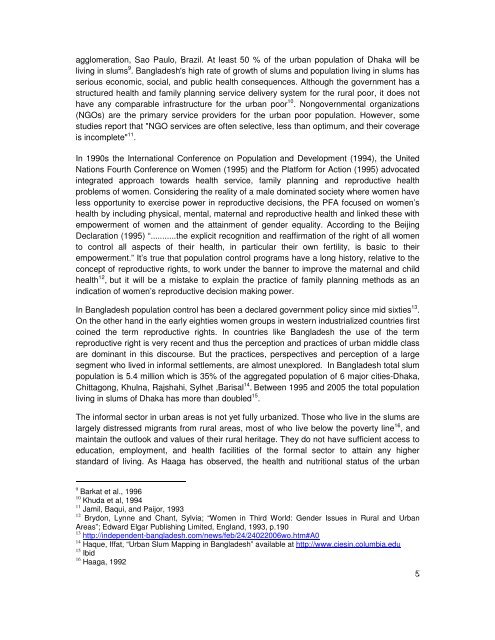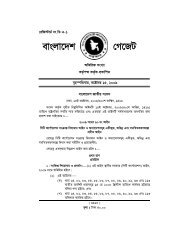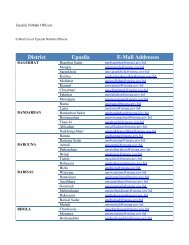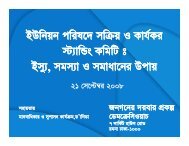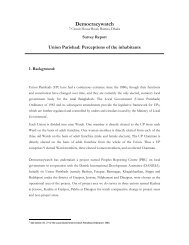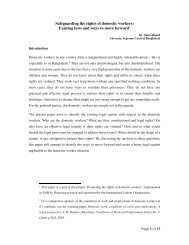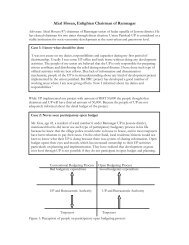Reproductive Decision Making Role among ... - Democracywatch
Reproductive Decision Making Role among ... - Democracywatch
Reproductive Decision Making Role among ... - Democracywatch
- No tags were found...
Create successful ePaper yourself
Turn your PDF publications into a flip-book with our unique Google optimized e-Paper software.
agglomeration, Sao Paulo, Brazil. At least 50 % of the urban population of Dhaka will beliving in slums 9 . Bangladesh's high rate of growth of slums and population living in slums hasserious economic, social, and public health consequences. Although the government has astructured health and family planning service delivery system for the rural poor, it does nothave any comparable infrastructure for the urban poor 10 . Nongovernmental organizations(NGOs) are the primary service providers for the urban poor population. However, somestudies report that "NGO services are often selective, less than optimum, and their coverageis incomplete" 11 .In 1990s the International Conference on Population and Development (1994), the UnitedNations Fourth Conference on Women (1995) and the Platform for Action (1995) advocatedintegrated approach towards health service, family planning and reproductive healthproblems of women. Considering the reality of a male dominated society where women haveless opportunity to exercise power in reproductive decisions, the PFA focused on women’shealth by including physical, mental, maternal and reproductive health and linked these withempowerment of women and the attainment of gender equality. According to the BeijingDeclaration (1995) “...........the explicit recognition and reaffirmation of the right of all womento control all aspects of their health, in particular their own fertility, is basic to theirempowerment.” It’s true that population control programs have a long history, relative to theconcept of reproductive rights, to work under the banner to improve the maternal and childhealth 12 , but it will be a mistake to explain the practice of family planning methods as anindication of women’s reproductive decision making power.In Bangladesh population control has been a declared government policy since mid sixties 13 .On the other hand in the early eighties women groups in western industrialized countries firstcoined the term reproductive rights. In countries like Bangladesh the use of the termreproductive right is very recent and thus the perception and practices of urban middle classare dominant in this discourse. But the practices, perspectives and perception of a largesegment who lived in informal settlements, are almost unexplored. In Bangladesh total slumpopulation is 5.4 million which is 35% of the aggregated population of 6 major cities-Dhaka,Chittagong, Khulna, Rajshahi, Sylhet ,Barisal 14 . Between 1995 and 2005 the total populationliving in slums of Dhaka has more than doubled 15 .The informal sector in urban areas is not yet fully urbanized. Those who live in the slums arelargely distressed migrants from rural areas, most of who live below the poverty line 16 , andmaintain the outlook and values of their rural heritage. They do not have sufficient access toeducation, employment, and health facilities of the formal sector to attain any higherstandard of living. As Haaga has observed, the health and nutritional status of the urban9 Barkat et al., 199610 Khuda et al, 199411 Jamil, Baqui, and Paijor, 199312 Brydon, Lynne and Chant, Sylvia; “Women in Third World: Gender Issues in Rural and UrbanAreas”; Edward Elgar Publishing Limited, England, 1993, p.19013 http://independent-bangladesh.com/news/feb/24/24022006wo.htm#A014 Haque, Iffat, “Urban Slum Mapping in Bangladesh” available at http://www.ciesin.columbia.edu15 Ibid16 Haaga, 1992


